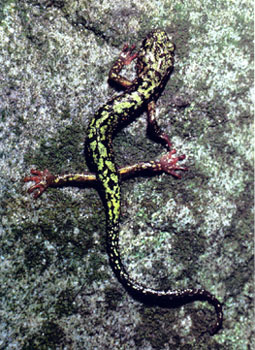Rare, Threatened and Endangered Animal Fact Sheet
Main_Content
Green Salamander | 
Green salamander, Aneides aeneus
Photograph by Edward Thompson | In most cases, the coloration of this cryptic salamander aids in camouflaging it against its lichen-covered rock habitat. It may vary in color from black to gray-brown with metallic green mottling, but since it is the only green salamander in the Appalachians, there is little chance of misidentifying it. This amphibian’s present range includes the mountainous regions of Ohio, southern Pennsylvania and western Maryland through eastern Tennessee to northern Mississippi and Georgia. The green salamander prefers shaded rock faces with plenty of moisture and crevices, which provide cool temperatures and high humidity throughout the dry summer. It is very discriminating about the types of crevices it chooses; they must interconnect throughout its rock habitat and cannot be too dry or too wet. Where conditions are optimal within a rock outcrop, the salamanders may be present in large numbers.
Mating and egg-laying occur in late May to early June. The female guards the eggs within a special crevice until the young hatch in September, looking like miniature replicas of adults. In the late fall, green salamanders retreat into deep rock crevices where they will hibernate over the long winter months. In Maryland, the green salamander has been found only in certain sandstone outcrops of Garrett County. Listed as a State Endangered Species in 1972, the salamander is monitored by Maryland Natural Heritage ecologists, who have succeeded in discovering several new populations.
|
|
